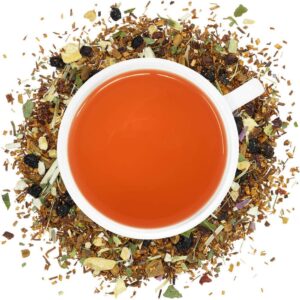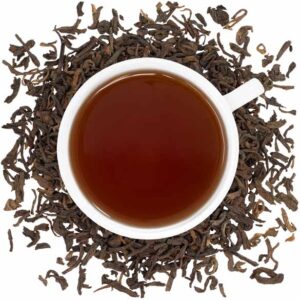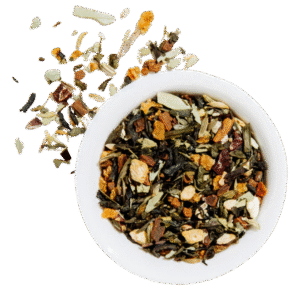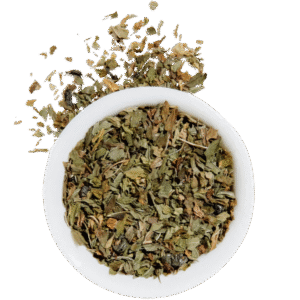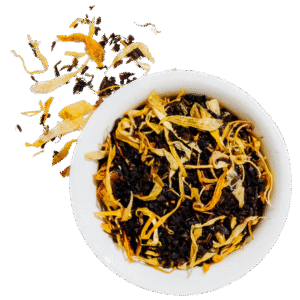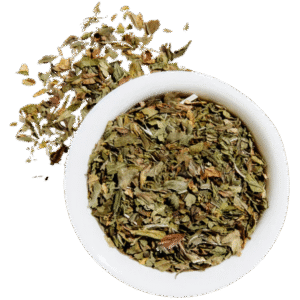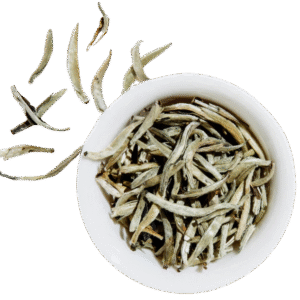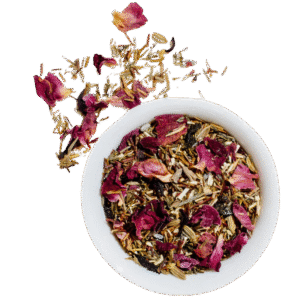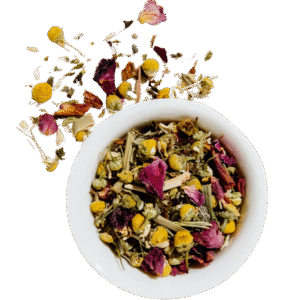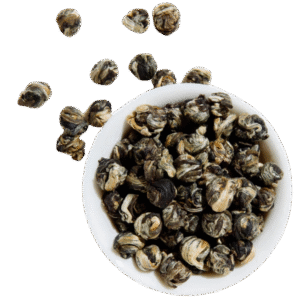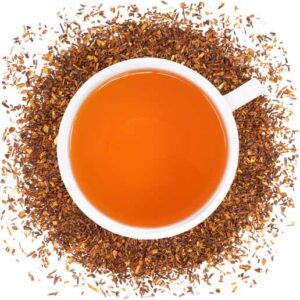Loose Leaf Teas
Why Loose Leaf Teas?
Health Benefits of Tea: Green, Black, and White Teas
All teas are derived from the Camellia sinensis plant, a shrub native to China and India, and contain unique antioxidants called polyphenols (including flavonoids). The most potent of these, known as ECGC, may help against free radicals that can contribute to cancer, heart disease, and clogged arteries.
All these teas also have caffeine and theanine, which affect the brain and seem to heighten mental alertness.
The more processed the tea leaves, usually the less polyphenol content. Polyphenols include flavonoids. Oolong and black teas are oxidized or fermented, so they have lower concentrations of polyphenols than green tea; but their antioxidizing power is still high.
Green Tea
The polyphenols, a large group of plant chemicals that includes the catechins (4), are thought to be responsible for the health benefits that have traditionally been attributed to tea, especially green tea. The most active and abundant catechin in green tea is epigallocatechin-3-gallate (EGCG). Made with steamed tea leaves, it has a high concentration of EGCG and has been widely studied. Green tea’s antioxidants may interfere with the growth of bladder, breast, lung, stomach, pancreatic, and colorectal cancers; prevent clogging of the arteries, burn fat, counteract oxidative stress on the brain, reduce risk of neurological disorders like Alzheimer’s and Parkinson’s diseases, reduce risk of stroke, and improve cholesterol levels. Green tea is used to improve mental alertness and thinking.
Some women use green tea to fight human papilloma virus (HPV), which can cause genital warts, the growth of abnormal cells in the cervix (cervical dysplasia), and cervical cancer.
It is also used for weight loss, headaches, bone loss (osteoporosis), Crohn’s disease, chronic fatigue syndrome (CFS), dental cavities (caries).
Instead of drinking green tea, some people apply green tea bags to their skin to soothe sunburn and prevent skin cancer due to sun exposure. Green tea bags are also used to decrease puffiness under the eyes, as a compress for tired eyes or headache, and to stop gums from bleeding after a tooth is pulled.
Green tea is used in an ointment for genital warts.
Black Tea
Made with fermented tea leaves, black tea has the highest caffeine content and forms the basis for flavored teas like chai, along with some instant teas. Studies have shown that black tea may protect lungs from damage caused by exposure to cigarette smoke.
Black Tea may also may reduce the risk of stroke. Black tea is used for improving mental alertness as well as learning, memory and information processing skills. It is also used for treating headache and low blood pressure; preventing heart disease, including “hardening of the arteries” (atherosclerosis) and heart attack; preventing Parkinson’s disease; and reducing the risk of stomach and colon cancer, lung cancer, ovarian cancer, and breast cancer.
Black tea is also used for type 2 diabetes, stomach disorders, vomiting, diarrhea, and as a diuretic to increase urine flow. Some people use black tea for preventing tooth decay and kidney stones. In combination with various other products, black tea is used for weight loss.
Black tea can help to reduce stress levels. A cup of black tea may be just what you need. One study found that black tea actually helped in reducing levels of the stress hormones in study participants.
White Tea
Uncured and unfermented. One study showed that white tea has the most potent anticancer properties compared to more processed teas. Recent studies at Pace University have shown that there is a major health benefit of white tea extract — it can kill bacteria, viruses, and fungi in the body with more success than other teas. The study focused primarily on the bacteria that cause Staphylococcus infections, Streptococcus infections, and pneumonia. The same study concluded that fluoride-rich white tea helps prevent the growth of dental plaque, the chief cause of tooth decay.
White tea is made from immature tea leaves that are picked shortly before the buds have fully opened. The healthy tea takes its name from the silver fuzz that still covers the buds, which turns white when the tea is dried. Immediately after harvesting, the leaves are steamed and dried, which keeps them from oxidizing and preserves the high antioxidant content. The result is a tea with a very delicate flavor, one that lacks the grassy aftertaste associated with green tea and has none of the tannins detected in black tea.
Because the tea leaf stays so close to its natural state, the benefit of white tea is that it contains more polyphenols, the powerful anti-oxidant that fights and kills cancer-causing cells, than any other type of tea. Another white tea health benefit is that it contains much less caffeine per cup than green, oolong, or black tea. This is due to the fact that the tea leaf is larger, underwent less processing, and is brewed in a cooler temperature than other teas.
Pu-Erh Tuo Cha
Pu-erh tea: Made from fermented and aged leaves. Considered a black tea, its leaves are pressed into cakes. Some studies have shown that pu-erh may lower cholesterol, lower blood pressure and increase metabolism.
In traditional Chinese medicine, Pu-erh tea is considered to open the meridians, ‘warm the middle burner’ (the spleen and stomach) and be beneficial to ‘blood cleansing’ and digestion. For these reasons, it is often consumed after heavy meals or drunk as a hangover cure.
Health Benefits of Tea: Herbal Teas
Made from herbs, fruits, seeds, or roots steeped in hot water, herbal teas have lower concentrations of antioxidants than green, white, black, and oolong teas. Their chemical compositions vary widely depending on the plant used.
Varieties include ginger, ginkgo biloba, ginseng, hibiscus, jasmine, rosehip, mint, rooibos (red tea), chamomile, and echinacea.
Chamomile
Insomnia and Relaxant: most people turn to chamomile tea for its nerve-soothing and sedative qualities. While chamomile’s effectiveness in humans hasn’t been scientifically proven, animal studies confirm that small amounts seem to relieve anxiety, while larger quantities aid sleep. UMMC suggests drinking 3 to 4 cups of chamomile tea each day for both sleeplessness and anxiety. Use either one teabag or 2 to 3 tsp. of loose tea for every cup of water. The UMMC states pregnant and nursing women should not consume the tea, which could increase the risk of miscarriage.
Immunity Booster: A 2005 study published in the American Chemical Society’s “Journal of Agricultural and Food Chemistry” found that volunteers who consumed 5 cups of chamomile tea for two weeks showed an increased level of hippurate. Hippurate is associated with the botanical phenolics that boost immunity by fighting bacteria. This may explain chamomile tea’s reputation for effectiveness in fighting colds and viruses, notes the American Chemical Society.
Menstrual Cramps and Tension: The same 2005 American Chemical Society study also found an increased level of the amino acid glycine in the test subjects’ systems after drinking chamomile tea for two weeks. Glycine helps reduce muscle spasms and relax nerves, including the uterine cramps and nervous tension related to the menstrual cycle. Because chamomile may also have an estrogenic effect, women with hormone-dependent tumors such as breast or uterine cancer shouldn’t drink it without talking first to their physician, the UMMC warns.
Infant Illness: Lukewarm chamomile tea is a traditional home remedy for infants and children suffering from colic, diarrhea and fever. The American Academy of Family Physicians confirms that chamomile tea may help soothe babies with colic, but that it’s helpful to show your pediatrician the tea’s label to ensure that the dose isn’t too strong. Because chamomile relaxes the muscles, it appears to soothe upset stomach and diarrhea. The UMMC recommends that children under 5 take no more than 1/2 cup of tea a day, while babies with colic should be given no more than 1 to 2 oz. per day. Make sure the liquid cools before giving it to children or babies.
Skin Conditions: Topical or oral use of chamomile tea may help soothe such skin problems as eczema, contact dermatitis and diaper rash, although the benefits haven’t been scientifically proven. Unfortunately, some patients may unwittingly make their condition worse by compounding the original skin problem with an allergic reaction to chamomile, warns the UMMC. If you have allergies to asters, daisies, chrysanthemums, or ragweed, you might also be allergic to chamomile.
Mouth Sores: Although treating the kind of mouth sores known as aphthous ulcers with chamomile tea falls under the “folk remedy/needs more research” category, the American Academy of Family Physicians says that a blend of chamomile and sage teas “may be helpful when used four to six times a day” as a mouthwash.
Mint
Upset Stomach: A cup of peppermint tea will soothe an upset stomach and relieve heartburn, according to the University of Wisconsin School of Medicine and Public Health. Although peppermint tea may also relieve symptoms of irritable bowel syndrome, enteric-coated tablets are believed to be more effective. Make tea for an upset stomach by pouring boiling water over 1 to 2 tsp. of dried peppermint leaves. Allow the tea to steep for five minutes. Brew peppermint tea from fresh peppermint leaves, dried tea leaves or tea bags.
Mental Focus: peppermint tea has a cool, refreshing flavor and an invigorating aroma that can help drivers stay alert, focused and less anxious. The aroma of peppermint tea can boost mental performance and promote focus, making tea a useful drink for students, employees in the workplace or anytime alertness and energy are required.
Coughs and Congestion: The menthol in a hot cup of herbal tea can help loosen congestion and relieve coughing associated with colds and allergies. Peppermint tea thins the mucus and acts as an expectorant to break up coughs, and can also relieve dry cough and sore throat, according to the University of Maryland Medical Center. Drink four to five cups of peppermint tea per day, between meals. Drink the tea as is, or add a few drops of lemon juice or a lemon slice.
Bad Breath: Peppermint tea can relieve bad breath caused by smoking, drinking alcohol or eating onions or garlic. Drink the peppermint tea hot or iced. Alternatively, gargle with cool peppermint tea.
Goji Berries
Research shows that eating berries — like blueberries, acai berries, cranberries, strawberries, and cherries — offer definite health benefits. It may be because berries like the goji berry are filled with powerful antioxidants and other compounds. Goji berries also have compounds rich in vitamin A.
Some studies using goji berry juice found benefits in mental well-being and calmness, athletic performance, happiness, quality of sleep, and feelings of good health. These are preliminary studies that need to be repeated before definitive conclusions can be drawn.
Ginger
Digestive Aid: Ginger stimulates good digestion, the basis of health. Ginger stimulates the digestive “fire” by helping the body to release the proper enzymes to break down food so nutrients can be easily absorbed. For people suffering from a loss of appetite, such as during chemotherapy, ginger can stimulate hunger.
Ginger has been proven to be a powerful treatment for nausea, morning sickness, and motion sickness. The studies touting the benefits of ginger are prevalent enough that many doctors recommend the use of ginger over prescription medications for nausea. For pregnant women who are suffering from severe cases of morning sickness and do not want to take medications, ginger offers safe, effective relief from their symptoms. Ginger is also excellent for getting rid of gas and abdominal pain due to intestinal spasms.
Anti-inflammatory: Ginger contains strong anti-inflammatory compounds called gingerols. These naturally occurring compounds help reduce pain and increase mobility in individuals who are suffering from rheumatoid arthritis and osteoarthritis. Ginger not only lowers inflammation but it also has molecules that improve joint circulation. In studies, ginger was as effective as ibuprofen for the treatment of osteoarthritis, but without any of the negative effects on the stomach associated with ibuprofen. In fact, ginger actually helps to alleviate stomach problems rather than cause them. People who are suffering from arthritis can add ginger to their daily routine to find relief from their pain without worrying about damaging their gut.
Immune Health: Ginger helps to cleanse the lymphatic system, which is our body’s sewage system. By opening up these lymphatic channels and keeping things clean, ginger prevents the accumulation of the toxins that make you susceptible to infections, especially in the respiratory system. It doesn’t take long to see the benefits of ginger when you have a sore throat and a cold. Ginger is a must-have food during flu season.
Valerian
Valerian is most commonly used for sleep disorders, especially the inability to sleep (insomnia). It is frequently combined with hops, lemon balm, or other herbs that also cause drowsiness. Valerian is also used for conditions connected to anxiety and psychological stress including nervous asthma, hysterical states, excitability, fear of illness (hypochondria), headaches, migraine, and stomach upset.
Some people use valerian for depression, mild tremors, epilepsy, attention deficit-hyperactivity disorder (ADHD), and chronic fatigue syndrome (CFS).
Valerian is used for muscle and joint pain. Some women use valerian for menstrual cramps and symptoms associated with menopause, including hot flashes and anxiety. Sometimes, valerian is added to bath water to help with restlessness and sleep disorders.
Valerian is often coupled with PASSIONFLOWER for the treatment of insomnia and anxiety.




